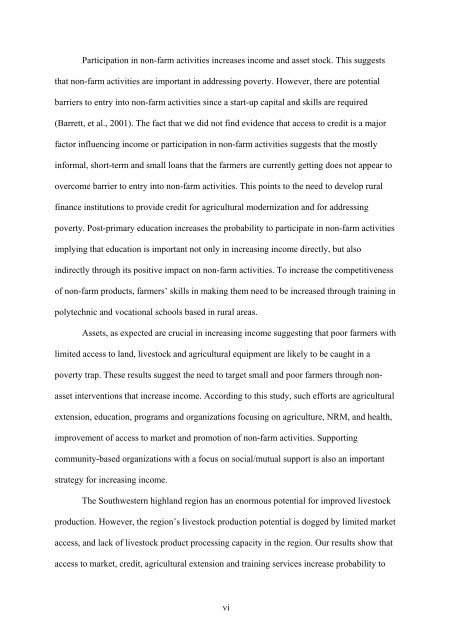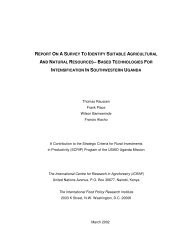community and household-level income & asset status baseline
community and household-level income & asset status baseline
community and household-level income & asset status baseline
Create successful ePaper yourself
Turn your PDF publications into a flip-book with our unique Google optimized e-Paper software.
Participation in non-farm activities increases <strong>income</strong> <strong>and</strong> <strong>asset</strong> stock. This suggests<br />
that non-farm activities are important in addressing poverty. However, there are potential<br />
barriers to entry into non-farm activities since a start-up capital <strong>and</strong> skills are required<br />
(Barrett, et al., 2001). The fact that we did not find evidence that access to credit is a major<br />
factor influencing <strong>income</strong> or participation in non-farm activities suggests that the mostly<br />
informal, short-term <strong>and</strong> small loans that the farmers are currently getting does not appear to<br />
overcome barrier to entry into non-farm activities. This points to the need to develop rural<br />
finance institutions to provide credit for agricultural modernization <strong>and</strong> for addressing<br />
poverty. Post-primary education increases the probability to participate in non-farm activities<br />
implying that education is important not only in increasing <strong>income</strong> directly, but also<br />
indirectly through its positive impact on non-farm activities. To increase the competitiveness<br />
of non-farm products, farmers’ skills in making them need to be increased through training in<br />
polytechnic <strong>and</strong> vocational schools based in rural areas.<br />
Assets, as expected are crucial in increasing <strong>income</strong> suggesting that poor farmers with<br />
limited access to l<strong>and</strong>, livestock <strong>and</strong> agricultural equipment are likely to be caught in a<br />
poverty trap. These results suggest the need to target small <strong>and</strong> poor farmers through non-<br />
<strong>asset</strong> interventions that increase <strong>income</strong>. According to this study, such efforts are agricultural<br />
extension, education, programs <strong>and</strong> organizations focusing on agriculture, NRM, <strong>and</strong> health,<br />
improvement of access to market <strong>and</strong> promotion of non-farm activities. Supporting<br />
<strong>community</strong>-based organizations with a focus on social/mutual support is also an important<br />
strategy for increasing <strong>income</strong>.<br />
The Southwestern highl<strong>and</strong> region has an enormous potential for improved livestock<br />
production. However, the region’s livestock production potential is dogged by limited market<br />
access, <strong>and</strong> lack of livestock product processing capacity in the region. Our results show that<br />
access to market, credit, agricultural extension <strong>and</strong> training services increase probability to<br />
vi

















